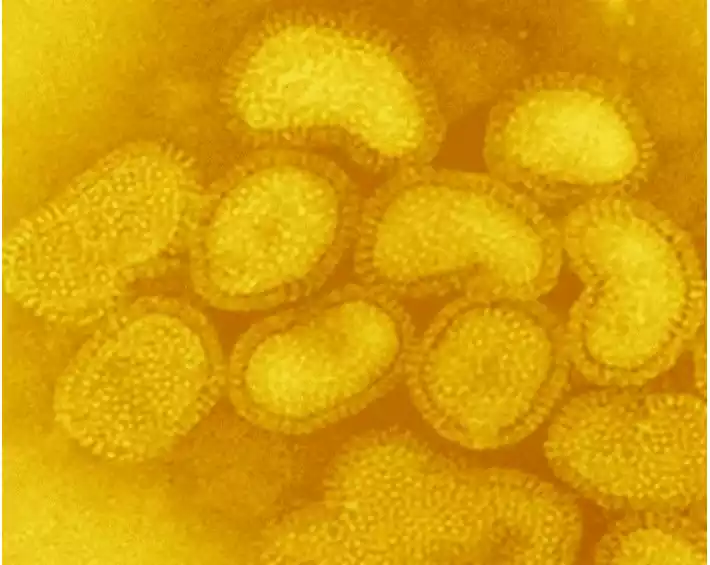Introduction of Orthomyxovirus and Paramyxovirus
Viruses are microscopic infectious agents that can cause disease in almost every form of life. Among the plethora of viral families that infect humans, the Orthomyxoviridae and Paramyxoviridae are two significant groups. Both have some shared traits and some crucial differences that impact their transmission, disease manifestation, and treatment approaches. This article delves into the distinctions and commonalities between the two.
Definition of Orthomxovirus
A type of virus belonging to the family Orthomyxoviridae. These viruses are characterized by their segmented, single-stranded, negative-sense RNA genome. The most prominent and well-known member of this family is the influenza virus, which causes influenza (flu) in various species. Due to the segmented nature of their genome, these viruses can exchange genetic material when co-infecting a host, leading to genetic reassortment.

This phenomenon can give rise to new viral strains with different antigenic properties, facilitating rapid adaptation and occasionally resulting in pandemic strains. The viruses are enveloped and possess surface proteins, notably hemagglutinin and neuraminidase, which play pivotal roles in the infection process.
Definition of Paramyxovirus
Paramyxoviruses are a group of RNA viruses that belong to the family Paramyxoviridae. They are characterized by a non-segmented, single-stranded, negative-sense RNA genome. The viruses in this family are enveloped and often have surface glycoproteins that facilitate attachment and entry into host cells. Members of the Paramyxoviridae family cause a variety of diseases in humans and animals.

Notable human pathogens in this family include the measles virus, mumps virus, respiratory syncytial virus (RSV), and human parainfluenza viruses. Some of these viruses, like the measles virus, have a unique ability to induce cell-to-cell fusion, leading to the formation of multi-nucleated giant cells or syncytia.
Characteristics
- Orthomyxovirus:
-
- Possess a segmented, single-stranded, negative-sense RNA genome.
- Enveloped viruses with surface glycoproteins.
- Replicate in the nucleus of the host cell.
- Known for antigenic drift and shift, leading to regular changes in virus strains.
- Paramyxovirus:
-
- Non-segmented, single-stranded, negative-sense RNA genome.
- Enveloped with surface glycoproteins.
- Replicate in the cytoplasm of the host cell.
- Some members possess a unique ability for cell-to-cell fusion, leading to syncytia formation.
Diseases Caused
- Orthomyxovirus: The primary disease caused by the Orthomyxovirus family is influenza. Influenza is a respiratory illness that can range from mild to severe, with potential complications such as pneumonia and secondary bacterial infections.
- Paramyxovirus: Members of this family cause a variety of diseases. These include measles, mumps, and respiratory infections like respiratory syncytial virus (RSV) and parainfluenza.
Comparison Table of Orthomyxovirus and Paramyxovirus
Here’s a comparison table highlighting the key differences between Orthomyxovirus and Paramyxovirus:
| Feature | Orthomyxovirus | Paramyxovirus |
|---|---|---|
| Family | Orthomyxoviridae | Paramyxoviridae |
| Genome | Segmented | Non-segmented |
| RNA Type | Single-stranded, negative-sense RNA | Single-stranded, negative-sense RNA |
| Notable Diseases | Influenza | Measles, Mumps, RSV, Parainfluenza |
| Replication Site | Nucleus | Cytoplasm |
| Envelope | Yes | Yes |
| Surface Proteins | Hemagglutinin, Neuraminidase | Hemagglutinin, Fusion protein |
| Genetic Reassortment | Possible due to segmented genome | Not common due to non-segmented genome |
This table offers a concise summary of the main differences and similarities between the two types of viruses. Both are significant human pathogens, but they exhibit some distinct characteristics that influence their behavior, transmission, and the diseases they cause.
Similarities of Orthomyxovirus and Paramyxovirus
- Both are enveloped viruses with a negative-sense RNA genome.
- Both families cause respiratory diseases in humans.
- Both utilize surface glycoproteins for host cell entry.
Transmission & Treatment
- Orthomyxovirus (e.g., Influenza virus)
Transmission:
- Respiratory droplets: When an infected person coughs or sneezes, the virus can be spread through the droplets that are expelled.
- Direct contact: Touching surfaces or objects with the virus on it and then touching one’s mouth, nose, or eyes.
- Airborne: In some cases, by breathing in the virus, especially in enclosed spaces.
Treatment:
- Antiviral medications: These can reduce the severity and duration of the illness. Common antiviral drugs for influenza include oseltamivir (Tamiflu), zanamivir (Relenza), and baloxavir marboxil (Xofluza).
- Supportive care: Includes rest, hydration, and over-the-counter pain relievers to alleviate symptoms.
- Hospitalization: In severe cases, especially for high-risk individuals, hospitalization may be necessary for more intensive supportive care.
- Paramyxovirus (e.g., Measles, Mumps, RSV)
Transmission:
- Respiratory droplets: Viruses like measles and mumps are highly contagious and can spread when an infected person coughs or sneezes.
- Direct contact: Touching an infected surface and then touching the face can lead to infection.
- Close personal contact: Some paramyxoviruses can spread through direct contact with an infected person’s saliva or other bodily fluids.
Treatment:
- Supportive care: Most paramyxoviral infections primarily require supportive treatments, such as rest, hydration, and fever reducers.
- Specific antivirals: For some paramyxoviruses like RSV, antiviral medication like ribavirin can be effective, although its use is limited and often reserved for severe cases.
- Hospitalization: Severe cases, especially in infants or immunocompromised individuals, may require hospitalization for monitoring and supportive care.
- Isolation: Given the contagious nature of diseases like measles, infected individuals may need to be isolated to prevent the spread.
For both types of viruses, prevention through vaccination (where available) remains the most effective strategy to avoid illness.
Impact on Human Health
Orthomyxovirus (primarily Influenza virus):
- Seasonal Epidemics: Every year, influenza viruses cause seasonal epidemics, leading to significant morbidity and mortality worldwide. Millions of people get infected, resulting in hospitalizations and deaths, especially among high-risk groups like the elderly, young children, and those with underlying health conditions.
- Pandemics: Historically, certain strains of the influenza virus have caused pandemics, resulting in substantial global health crises. Examples include the Spanish flu in 1918, which led to millions of deaths worldwide.
- Secondary Complications: Influenza can lead to secondary bacterial infections, including pneumonia, bronchitis, sinus, and ear infections. These complications can be life-threatening, especially in vulnerable populations.
- Economic Impact: Frequent sick leaves, medical costs, and hospitalizations during flu seasons exert considerable strain on the economy.
Paramyxovirus:
- Measles:
- Highly Contagious: Measles is one of the most contagious diseases known. Before the introduction of the measles vaccine, outbreaks were common.
- Complications: Measles can lead to severe complications, including encephalitis (brain swelling), pneumonia, and even death, especially in malnourished children and those with weakened immune systems.
- Subacute sclerosing panencephalitis (SSPE): A rare, but fatal, neurological disorder that can appear years after a person has recovered from measles.
- Mumps:
- Complications: While mumps often presents as a mild illness, complications can include orchitis (swelling of the testicles), oophoritis (swelling of the ovaries), pancreatitis, and in rare cases, deafness or encephalitis.
- Respiratory Syncytial Virus (RSV):
- Severe Respiratory Illness: RSV is a significant cause of respiratory illness in young children, leading to bronchiolitis or pneumonia. Hospitalizations are common among infants.
- Vulnerable Populations: In addition to infants, elderly adults and those with underlying health conditions can experience severe RSV disease.
- Parainfluenza:
- Respiratory Illness: Human parainfluenza viruses cause respiratory illnesses ranging from cold-like symptoms to croup, bronchitis, and pneumonia.
Orthomyxoviruses and Paramyxoviruses have a profound impact on human health. While the nature and extent of diseases they cause vary, both families of viruses represent significant public health challenges. Vaccination and public health interventions remain crucial tools in reducing the burden of these diseases.
Prevention and Vaccination
- Orthomyxovirus (primarily Influenza virus)
Prevention:
- Hand Hygiene: Regular handwashing with soap and water or using hand sanitizers can reduce the risk of transmission.
- Respiratory Etiquette: Coughing or sneezing into the elbow or a tissue and promptly discarding the tissue can prevent the spread of droplets containing the virus.
- Avoid Close Contact: Keeping distance from sick individuals and avoiding crowded places during flu season can minimize the risk of infection.
- Sanitization: Regular cleaning and disinfecting of surfaces can reduce the chances of contracting the virus from contaminated objects.
Vaccination:
- Annual Vaccination: Because the influenza virus evolves rapidly, annual flu vaccines are developed to target the most prevalent strains anticipated for each season. Vaccination is the most effective way to prevent influenza infection and its complications.
- Vulnerable Populations: It’s especially important for high-risk groups (elderly, children, pregnant women, healthcare workers, and individuals with chronic conditions) to get vaccinated annually.
- Paramyxovirus
Prevention:
- Hand Hygiene: Regular handwashing can significantly reduce the risk of transmission for viruses like measles and mumps.
- Avoid Close Contact: Keeping distance from infected individuals, especially in outbreaks.
- Isolation: Infected individuals should be isolated to prevent the spread of highly contagious viruses like measles.
- Respiratory Etiquette: As with influenza, covering mouth and nose while coughing or sneezing can reduce the spread of respiratory droplets.
Vaccination:
- MMR Vaccine: The MMR (measles, mumps, and rubella) vaccine is a combined vaccine that provides protection against measles, mumps, and rubella. It’s typically given in two doses, with the first dose administered around the age of one and the second dose before starting school.
- RSV Prophylaxis: Palivizumab (Synagis) is a monoclonal antibody given to certain high-risk infants and children to prevent severe RSV illness. It’s not a vaccine but provides temporary protection.
- Parainfluenza: Currently, there is no specific vaccine for human parainfluenza viruses, but research is ongoing.
For both virus families, while vaccines play a critical role in preventing illness, practicing good hygiene and following public health guidelines are equally essential in limiting the spread and impact of these diseases.
Summary
While Orthomyxoviruses and Paramyxoviruses share some similarities, their differences in genome structure, replication, and disease manifestation make them distinct entities. Understanding these differences is crucial for effective treatment, prevention, and control of the diseases they cause. Vaccination remains the most potent weapon against many of these viral infections, highlighting the importance of continued research and public health interventions.































